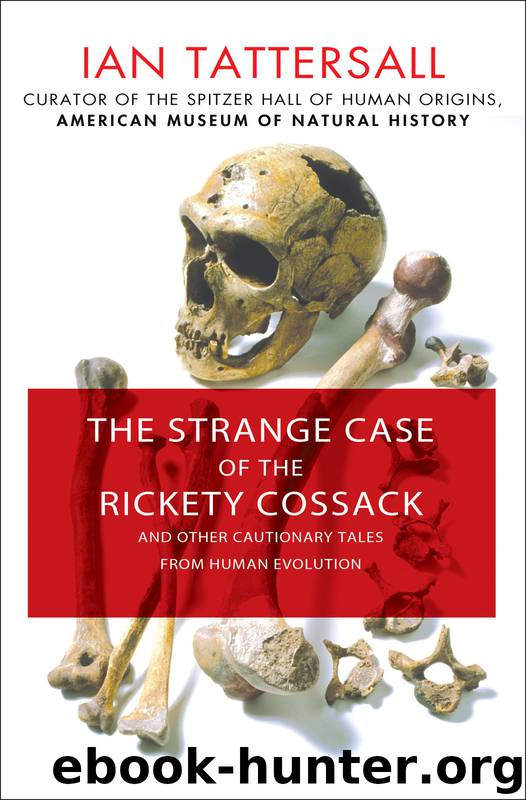The Strange Case of the Rickety Cossack by Ian Tattersall

Author:Ian Tattersall [Tattersall, Ian]
Language: eng
Format: epub
Publisher: St. Martin's Press
Published: 2015-04-20T04:00:00+00:00
East African hominid fossils discussed in this chapter. Left: “Lucy” skeleton, MNE AL 288, from Hadar, Ethiopia, assigned to Australopithecus afarensis. Upper right: Bodo cranium from Middle Awash, Ethiopia, first mooted as a Homo erectus but now often seen as Homo heidelbergensis. Lower right: comparatively recent partial skull LH 18, from Laetoli, Tanzania. Crania to scale. Drawn by Don McGranaghan.
The Middle Awash and Laetoli
Meanwhile, many other things had also been happening in Ethiopia, entertainingly chronicled by Jon Kalb in his 2001 book Adventures in the Bone Trade, mandatory reading (along with Eustace Gitonga and Martin Pickford’s Richard Leakey: Master of Deceit) for anyone interested in the sociopolitical dynamics of the Gilded Age of paleoanthropology in eastern Africa. To cut a long story short, after much internecine intrigue the Afar team splintered in late 1974. Johanson and his French colleagues remained at Hadar, while Kalb shifted his attentions a little way upriver, to an area of badlands known as the Middle Awash. In 1976 his team discovered a hominid cranium, now known to be about 600,000 years old, at the Middle Awash site of Bodo. At 1,250 ml, its brain volume was fairly respectable, and the closest morphological comparison seemed to be with the Broken Hill (now Kabwe) skull from Zambia that Arthur Smith Woodward had assigned to Homo rhodesiensis. Diplomatically, its discoverers reported that the Bodo cranium was “less archaic” than Asian H. erectus, but “more archaic” than the quite recent materials Richard Leakey had reported from Omo Kibish. The Middle Awash, where sporadically exposed fossil-bearing rocks document the last 6 million years, eventually came to loom large in the history of paleoanthropology. But back in the 1970s the discoveries most germane to the interpretation of the Hadar fossils were being made far to the south, at Laetoli in Tanzania.
Laetoli, not very far from Olduvai, had first been visited by the elder Leakeys back in the 1930s, when they had recovered a primate lower canine tooth. At the time they thought it was a monkey’s, but it later turned out to have belonged to an early hominid. A few years later, the German explorer Ludwig Kohl-Larsen found a fragment of lower jaw not far away. In 1950 another German, Hans Weinert, concluded that this mandible belonged to Franz Weidenreich’s Javan genus Meganthropus, and created the new species Meganthropus africanus for it. There things rested until Mary Leakey returned to Laetoli in 1974. Over the next eight years Mary’s team discovered some 30 early hominid fossils, ranging from isolated teeth to two quite complete lower jaws (LH—for Laetoli Hominid—2 and 4) that were between 3.6 and 3.8 million years old. It also found a fairly complete skull in the much later Ngaloba Beds that are also exposed in the area. This specimen (LH 18) came in with a cranial volume of around 1,200 ml, and the two anatomists who described it rather noncommittally remarked on its general resemblances to other “archaic Homo sapiens” crania from Africa.
The real jewels of the Laetoli fieldwork, though, were fossils of another kind altogether: trackways preserved in ancient ashfalls.
Download
This site does not store any files on its server. We only index and link to content provided by other sites. Please contact the content providers to delete copyright contents if any and email us, we'll remove relevant links or contents immediately.
| Anatomy | Animals |
| Bacteriology | Biochemistry |
| Bioelectricity | Bioinformatics |
| Biology | Biophysics |
| Biotechnology | Botany |
| Ecology | Genetics |
| Paleontology | Plants |
| Taxonomic Classification | Zoology |
Sapiens: A Brief History of Humankind by Yuval Noah Harari(14320)
The Tidewater Tales by John Barth(12626)
Mastermind: How to Think Like Sherlock Holmes by Maria Konnikova(7278)
Do No Harm Stories of Life, Death and Brain Surgery by Henry Marsh(6905)
The Thirst by Nesbo Jo(6879)
Why We Sleep: Unlocking the Power of Sleep and Dreams by Matthew Walker(6655)
Life 3.0: Being Human in the Age of Artificial Intelligence by Tegmark Max(5516)
Sapiens by Yuval Noah Harari(5323)
The Longevity Diet by Valter Longo(5042)
The Body: A Guide for Occupants by Bill Bryson(5029)
The Rules Do Not Apply by Ariel Levy(4910)
The Immortal Life of Henrietta Lacks by Rebecca Skloot(4550)
Animal Frequency by Melissa Alvarez(4428)
Why We Sleep by Matthew Walker(4394)
The Hacking of the American Mind by Robert H. Lustig(4339)
Yoga Anatomy by Kaminoff Leslie(4333)
All Creatures Great and Small by James Herriot(4271)
Double Down (Diary of a Wimpy Kid Book 11) by Jeff Kinney(4241)
Embedded Programming with Modern C++ Cookbook by Igor Viarheichyk(4141)
